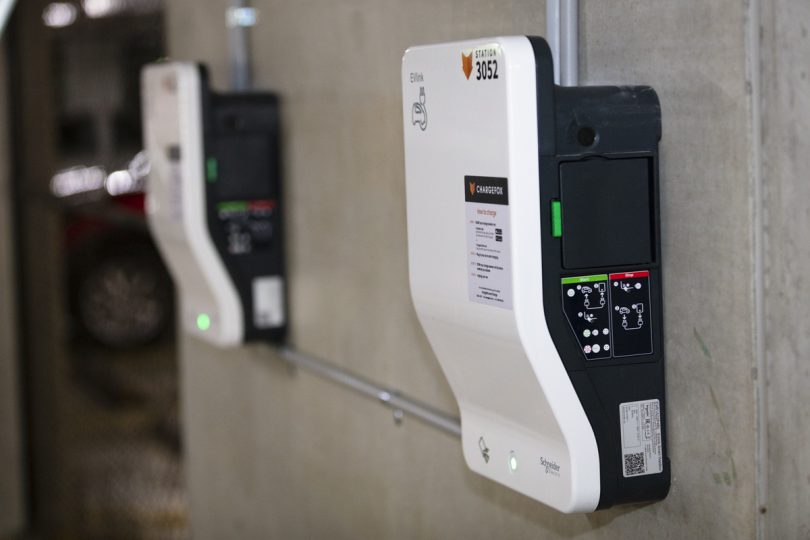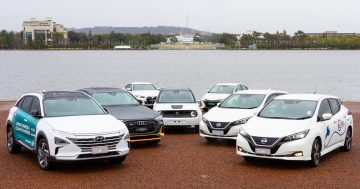
Owners of properties at IQ Smart Apartments, Robert Azzopardi (left) and Jo Elkington (centre) with Vantage Strata’s Peter Zakharoff (right). Photo: Thomas Lucroft.
Residents at IQ Smart Apartments in Braddon say the installation of electric vehicle (EV) chargers in their basement carpark is one of the ways the strata committee is adding value to the apartments and ensuring owners have access to the latest technology.
In a first for Canberra, the residential complex’s strata committee has retrofitted EV chargers to ensure owners are futureproofing their homes.
“There are residents and visitors to the building who have electric vehicles,” says IQ Smart Apartments strata committee member Robert Azzopardi. “We wanted a system everyone could use, now and into the future.
“We’ve installed a generic charger which will work with any make and model rather than having owners install their own for their specific vehicle make.”
Vantage Strata managing director Chris Miller says it is important for strata committees to keep up with the latest in technology for their building to ensure they stay relevant to the day-to-day needs of owners and make best use of available technology.
“It’s becoming more important that privately owned strata title and mixed-use buildings keep pace with community expectation when it comes to amenities, particularly in the area of technology,” he said.

The generic charging stations at IQ Smart Apartments are supplied by JET Charge. Photo: Thomas Lucroft.
“It’s incumbent upon strata managers to be plugged in with developments and advances in technology and building operations. Not just EV chargers, but other green initiatives such as solar panels and advanced tech that might not be as obvious – access control and security monitoring; upgrading building infrastructure so people can access the building in the elevator using a code from their mobile phone; and licence plate recognition for building security and resident access to car parks.
“Those things are either coming or are already here, and it’s important strata managers are ahead of the game,” says Chris.
Residents at IQ Smart Apartments will now be able to fully charge their electric vehicles in the building’s basement car park overnight.
The technology is supplied by JET Charge, an Australian company that has installed more EV chargers than any other business in the country. Payment app Chargefox is also an Australian initiative, and it ensures only the owners are able to recharge.
“Electric vehicles aren’t going away,” says Robert. “They’re going to become the norm. Companies such as Volvo won’t even produce internal combustion engines after 2023, and Hyundai and Kia are expanding their range of EVs.
“We’ve got an owner with a Tesla and she needed to install a charger for it. We wanted the infrastructure to be generic so we used JET Charge stations and Chargefox. We put four of them in.
“We’re trying to keep up with the latest trends. We put in solar panels in April and we’ve seen a 60 per cent reduction in the common area’s electricity bill. That saves $30,000 a year on electricity that we can use elsewhere or refund to owners. And now we’ve put in the car chargers.
“The time will come when people won’t buy into an apartment without a charging facility.”
Chris agrees there will be a greater number of electric cars in the future, and buildings must be kept efficient and environmentally friendly.
“The chargers are one step towards putting smart tech in the building,” he says. “I expect we’ll see more buildings retrofit car chargers and other intelligent infrastructure.”





















